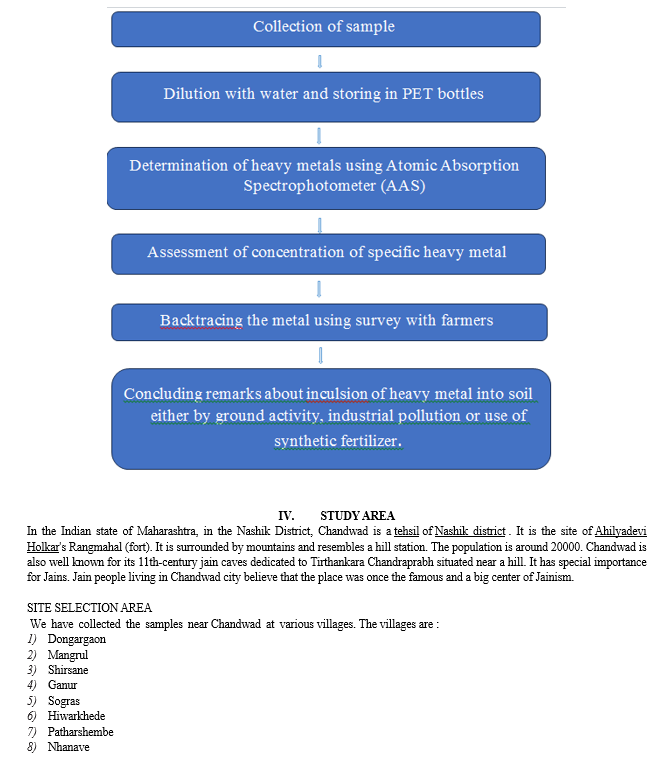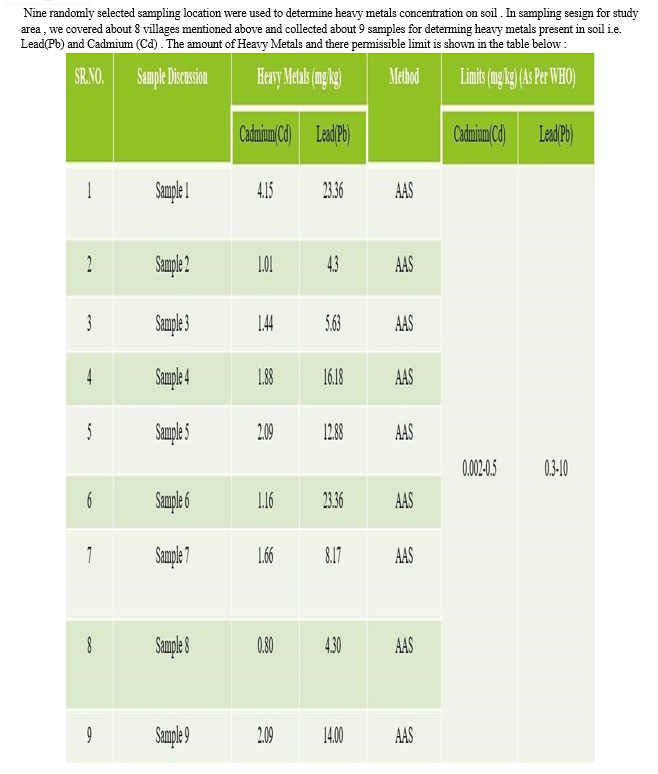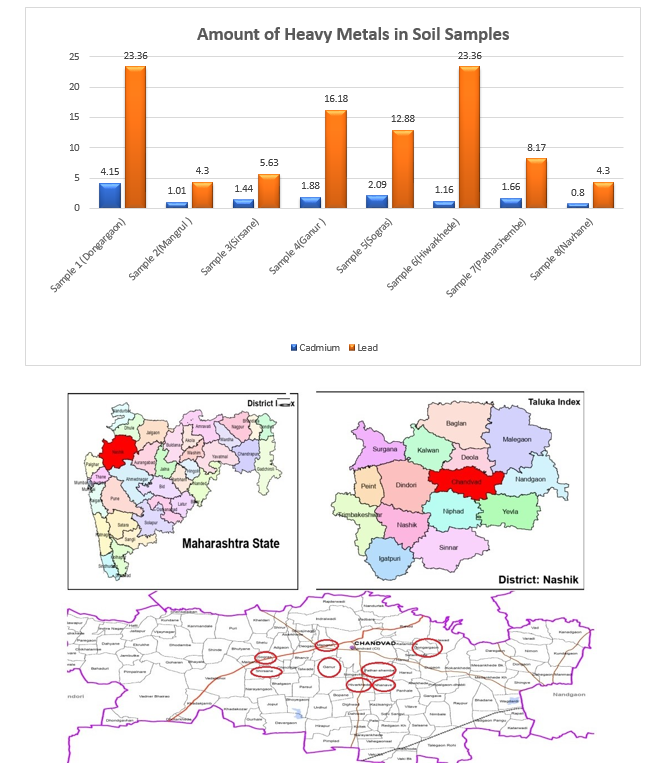Ijraset Journal For Research in Applied Science and Engineering Technology
- Home / Ijraset
- On This Page
- Abstract
- Introduction
- Conclusion
- References
- Copyright
Determination of Heavy Metals in Soil Sample
Authors: Prof. Mr. S. P. Harkal, Girish Marsale, Kirti Jadhav, Rutuja Shewale, Priyani Gautam, Kirti Pawar
DOI Link: https://doi.org/10.22214/ijraset.2024.62878
Certificate: View Certificate
Abstract
The swift industrialization and urban expansion of contemporary society have notably escalated the release of heavy metals into the environment, posing grave threats to soil quality and ecosystem wellbeing. This investigation aimed to evaluate the concentration of heavy metals in a soil sample procured from [Chandwad], employing an extensive analysis methodology utilizing Inductively Atomic Absorption Spectrophotometer (AAS). The heavy metals scrutinized encompassed lead (Pb), cadmium (Cd). The soil sample, meticulously collected to ensure representativeness, underwent rigorous preparation procedures, including air-drying, grinding, and sieving. The acid digestion method, employing a blend of nitric and hydrochloric acids, was utilized to extract heavy metals from the soil matrix, guaranteeing thorough dissolution of the sample. Instrumental analysis was carried out using AAS, renowned for its sensitivity and precision in determining trace metal concentrations. Calibration of the instrument was executed using certified reference materials (CRMs) and standard solutions of known concentrations. The outcomes revealed diverse concentrations of heavy metals in the soil, which were critically juxtaposed against regulatory standards and guidelines established by environmental protection agencies such as the Environmental Protection Agency (EPA). Quality control measures, including blanks, duplicates, and standard deviations, were integrated to authenticate the accuracy and precision of the results. The discussion encompasses the environmental ramifications of the observed heavy metal concentrations, considering potential sources, ecological risks, and the impact on soil quality. The study significantly contributes to the comprehension of the environmental health of the studied area and underscores the necessity for continued monitoring and remediation efforts. In summary, this investigation furnishes invaluable insights into the heavy metal composition of the soil in [Chandwad], providing a basis for informed decision-making regarding environmental management and regulatory compliance. Recommendations for further actions, including sustained monitoring and potential remediation strategies, are deliberated based on the acquired results. The study underscores the importance of proactive measures to alleviate the impact of heavy metals on soil ecosystems and human health.
Introduction
I. INTRODUCTION
This research aims to investigate and quantify the levels of heavy metals in soil samples collected from various locations. The analysis and determination of heavy metal concentrations will provide essential data for evaluating potential environmental risks, establishing appropriate soil management practices, and informing policies that promote sustainable land use. Soil is the material that is found on the earth's surface and is made of organic and inorganic material. The typical soil consists of about 45% mineral, 5% organic matter, 20- 30% water, and 20-30% air. It is a blend of natural issue, minerals, gases, fluids, and living beings that together help to the existence of many life forms that have evolved on our planet. The Earth's body of soil is the pedosphere, which has four vital functions: it is a medium for plant growth, it is a means of water storage, supply and purification, it is a modifier of Earth's atmosphere. it is natural surroundings for living beings .
II. LITERATURE REVIEW
Ashutosh Maurya , Lav Kesharwani know that the soil is the most important component of earth ecosystem, which has four key functions: it is a means for the growth of plants, is a means of storage, supply and purification of water, is a modifier of the earth’s atmosphere. Soils can be infected by the accumulation of heavy metals and metalloids through the emissions of industrial waste, elimination of high quality metal waste, application of soil fertilizers, sludge purification, pesticides, sewage irrigation, coal combustion residues, petrochemical spills and atmospheric storage. Even though heavy metals are naturally found in the soil, geological and anthropogenic activities increase the concentration of heavy metals in harmful quantities which is dangerous for both plants and animals. In forensic science heavy metal analysis of soil Heavy metal is providing a unique fingerprint of any soil.
The goal of this study will to determine if there is a correlation between land use type and concentrations of heavy metals in soil and characterization of soil .Atomic absorption spectrometry (AAS) is a technique which is helpful to measuring the quantities of trace elements present in soil samples.
Aijiun Yaoga , Zhang Jiantao know that the soil is the most important component of earth ecosystem, which has four key functions: it is a means for the growth of plants, is a means of storage, supply and purification of water, is a modifier of the earth's atmosphere. Soils can be infected by the accumulation of heavy metals and metalloids through the emissions of industrial waste, elimination of high quality metal waste, application of soil fertilizers, sludge purification, pesticides, sewage irrigation, coal combustion residues, petrochemical spills and atmospheric storage. Even though heavy metals are naturally found in the soil, geological and anthropogenic activities increase the concentration of heavy metals in harmful quantities which is dangerous for both plants and animals. The goal of this study will to determine the concentrations of four heavy metals (Cd, Ni, Cu, Zn) in soil that found in Stream of Sewage treatment and Industrialization Atomic absorption spectrometry (AAS) is a technique, which is helpful to measuring the quantities of trace elements present in soil samples.
Ali Sungur , Mustafa Soylak studied surface soil and corn cob samples were collected from 15 different agricultural fields of Çanakkale, Turkey. These samples were analysed to determine the concentration of Cd, Cu, Mn, Ni, Pb and Zn. BCR sequential extraction was used to extract the binding forms of the metals in the soil samples. At the same time, a wet digestion method was used to determine the total concentration of heavy metals in soil and corn grain samples. The metal concentrations in the extracted phase were measured with flame atomic absorption spectrometer. The accuracy of the methods was confirmed by using BCR-701 and SRM 1570 a certified reference materials. The results revealed that the quantity of the mobile fractions (i.e., acid soluble, reducible, and oxidisable) of the Mn, Cd and Pb were higher than that of the immobile fractions (residual). This might be caused by the anthropogenic sources. Pearson’s correlation was applied to determine the correlations between the selected physicochemical properties of soil samples and the amounts of heavy metals in each fraction. The pH, CaCO3 and organic matter contents of soil samples played a dominant role in correlations of heavy metals in various forms and shapes.
Rania Dghaim, Safa Al Khatib aimed at determining the concentration of heavy metals in selected traditional herbs consumed in the United Arab Emirates (UAE). A total of 81 samples of seven herbs, parsley (Petroselinum crispum), basil (Ocimum basilicum), sage (Salvia officinalis), oregano (Origanum vulgare), mint (Mentha spicata), thyme (Thymus vulgaris), and chamomile (Matricaria chamomilla), were purchased from the local market in Dubai and analyzed for their cadmium, lead, copper, iron, and zinc contents. Microwave-assisted digestion was applied for the dissolution of the samples and heavy metals concentration was determined using Atomic Absorption Spectrometry (AAS). Metals were found to be present in varied concentrations in the herb samples. The concentration ranges were found as follows: less than 0.1–1.11 mg⋅kg−1 for cadmium, less than 1.0–23.52mg⋅kg−1 for lead, 1.44–156.24mg⋅kg−1 for copper, 12.65–146.67mg⋅kg−1 for zinc, and 81.25–1101.22mg⋅kg−1 for iron. The findings of the study suggest that most of the analyzed herbs contained unsafe levels of heavy metals that exceeded the World Health Organization (WHO) permissible limits (PL).
Roslaili Abdul Aziz collected fifteen samples each of paddy soil and rice plants from the paddy field area affected by ultrabasic soil contamination in Ranau Valley, Sabah. Soil and rice plant samples were analyzed for heavy metals i.e: As, Cd, Co, Cr, Cu, Ni and Zn concentrations. The samples were extracted for their total heavy metals content by wet digestion method and then determined using ICP-MS. Results of soil samples indicated high concentrations of Co, Cr, Cu, Ni and Zn but low concentrations of As and Cd. Concentrations of Co, Ni and Cr exceeded the maximum allowable concentration (MAC) and trigger action value (TAV). Biological absorption coefficient (BAC) analysis showed that the rice plants were categorized as non-accumulator of Cr and Ni, low accumulator of As, Co and Cu and moderate accumulator of Cd and Zn. Bioavailability of heavy metals in Ranau Valley paddy fields was low despite the high concentration of heavy metals in the soil.
III. METHODOLOGY
To determine heavy metals in soil samples , step-by-step procedure is followed.
A general strategy to determine heavy metals is as follows :



V. DISCUSSION
- Sample 1 : The sample under discussion was collected from a farm located in the village of Dongargaon, which falls within the jurisdiction of Taluka Chandwad. The owner of this farm is identified as Deep Thakare. To determine the concentration of heavy metals present within this sample, the Atomic Absorption Spectroscopy (AAS) method was employed a technique widely recognized for its accuracy and sensitivity in the quantitative analysis of heavy metals in various matrices. Upon analysis, the concentration of lead (Pb) in the sample was found to be 23.36 mg/kg. And Additionally, the cadmium (Cd) concentration was determined to be 4.15 mg/kg.
- Sample 2 : The sample under discussion was collected from a farm located in the village of mangrul, which falls within the jurisdiction of Taluka Chandwad. The owner of this farm is identified as Bapu More. To determine the concentration of heavy metals present within this sample, the Atomic Absorption Spectroscopy (AAS) method was employed a technique widely recognized for its accuracy and sensitivity in the quantitative analysis of heavy metals in various matrices. Upon analysis, the concentration of lead (Pb) in the sample was found to be 1.01 mg/kg. And Additionally, the cadmium (Cd) concentration was determined to be 4.3 mg/kg.
- Sample 3 : The sample under discussion was collected from a farm located in the village of Sirsane, which falls within the jurisdiction of Taluka Chandwad. The owner of this farm is identified as Pratik deshmane. To determine the concentration of heavy metals present within this sample, the Atomic Absorption Spectroscopy (AAS) method was employed a technique widely recognized for its accuracy and sensitivity in the quantitative analysis of heavy metals in various matrices. Upon analysis, the concentration of lead (Pb) in the sample was found to be 5.63mg/kg. And Additionally, the cadmium (Cd) concentration was determined to be 1.44 mg/kg.
- Sample 4 : The sample under discussion was collected from a farm located in the village of Ganur, which falls within the jurisdiction of Taluka Chandwad. The owner of this farm is identified as Sandesh Nirbhavane. To determine the concentration of heavy metals present within this sample, the Atomic Absorption Spectroscopy (AAS) method was employed a technique widely recognized for its accuracy and sensitivity in the quantitative analysis of heavy metals in various matrices. Upon analysis, the concentration of lead (Pb) in the sample was found to be 16.18 mg/kg. And Additionally, the cadmium (Cd) concentration was determined to be 1.88 mg/kg
In the preceding discussion, we provided detailed explanations for Samples 1 through 4, encompassing a comprehensive analysis of their characteristics, results, and implications. For Samples 5 through 8, we have summarized their readings in the table above .
Conclusion
1) The effectiveness of Atomic Absorption Spectroscopy (AAS) in identifying and measuring heavy metals in soil samples is confirmed by this investigation. 2) The utilisation of AAS is recommended for environmental monitoring due to its exceptional sensitivity, accuracy, and specificity. 3) Heavy metal prevalence was determined by the study, which showed that soil samples included high concentrations of lead (Pb), cadmium (Cd). 4) As shown in above charts , the amount of lead and cadmium were greater than there limits. 5) As per project ,we conclude that our samples limits are higher and the project completes successfully.
References
[1] P Ashutosh Maurya 1, Lav Kesharwani 2, Munish Kumar Mishra 3 “Analysis of Heavy Metal in Soil through Atomic Absorption Spectroscopy for Forensic Consideration” Volume 6 Issue VI,June 2018- Available at www.ijraset.com.2018 [2] Ali Sungur, Mustafa Soylak & Hasan Ozcan “Investigation of heavy metal mobility and availability by the BCR sequential extraction procedure: relationship between soil properties and heavy metals availability” Department of Chemistry, Faculty of Sci.s, Erciyes University, Kayseri, Turkey,Vol.26(4) , 2015. [3] Rania Dghaim,SafaAlKhatib, HusnaRasool, and MunawwarAliKhan “Determination of Heavy Metals Concentration in Traditional Herbs Commonly Consumed in the United Arab Emirates” Journal of Environmental and Public Health Vol.2015 April 2015. [4] CARMEN PENELOPI PAPADATU1, MARIAN BORDEI “Researches on Heavy Metals Determination from Water and Soil in Galati County, Romania” https://www.researchgate.net/publication/312127789 vol 2016. September2016. [5] Perihan Binnur Kurt-Karakus “Determination of heavy metals in indoor dust from Istanbul, Turkey: Estimation of the health risk” www.elsevier.com/locate/envint, Vol 47–55, 2014. [6] Wan Mohd Razi Idris and Md. Atiqur Rahman Bhuiyan “Determination of Heavy Metals Uptake in Soil and Paddy Plants” IDOSI Publications, 2015 vol.15(2) 2015 [7] Ashwini A. Waoo1*, Swati Khare2, Sujata Ganguli “Extraction and Analysis of Heavy Metals from Soil and Plants in the Industrial Area Govindpura, Bhopal” Volume 1, Number 2, July 2014 [8] Isa, Koki1 and Jimoh, W. L. O.2 “DETERMINATION OF HEAVY METALS IN SOILS FROM DUMP SITE OF TANNERIES AND FARMLANDS IN CHALLAWA INDUSTRIAL ESTATE KANO,NIGERIA” Bayero Journal of Pure and Applied Sciences, 6(2): 57 – 64,2013 [9] Kebir Tahar and Bouhadjera Keltoum “Effects of Heavy Metals Pollution in Soil and Plant in the Industrial Area, West ALGERIA” Journal of the Korean Chemical Society, Vol.55,2011. [10] Abbas Hani·Ebrahim Pazira “Heavy metals assessment and identification of their sources in agricultural soils of Southern Tehran, Iran” ©Springer Science+Business Media B.V. 2010. Vol 176:677–691. [11] Trueby, P., 2003. Impact of Heavy Metals on Forest Trees from Mining Areas, Ontario, Canada: International Conference on Mining and the Environment III. 14. McBride, M.B., 2007. [12] Trace Metals and Sulfur in Soils and Forage of a Chronic Wasting Disease Locus. Journal of 4: 134-139. Environmental Chemistry, 15. McBride, M.B., 2003. [13] Toxic metals in Sewage Sludge-amended Soils: Has Promotion of Beneficial Use Discounted the Risks? Journal of Advances in Environmental Resource, 8: 5-1 [14] Christoph Moor1,*, Theopisti Lymberopoulou2 , and Volker J. Dietrich3 “Determination of Heavy Metals in Soils, Sediments and Geological Materials by ICP-AES and ICP-MS” Springer-Verlag 200 I Printed in Austria vol.128-123, 2001 [15] F. Capitelli a, F. Colao b, M.R. Provenzano a, R. Fantoni b, G. Brunetti a, N. Senes “Determination of heavy metals in soils by Laser Induced Breakdown Spectroscopy” www.elsevier.comrlocatergeoderma vol.45 feb 2001
Copyright
Copyright © 2024 Prof. Mr. S. P. Harkal, Girish Marsale, Kirti Jadhav, Rutuja Shewale, Priyani Gautam, Kirti Pawar. This is an open access article distributed under the Creative Commons Attribution License, which permits unrestricted use, distribution, and reproduction in any medium, provided the original work is properly cited.

Download Paper
Paper Id : IJRASET62878
Publish Date : 2024-05-28
ISSN : 2321-9653
Publisher Name : IJRASET
DOI Link : Click Here
 Submit Paper Online
Submit Paper Online

